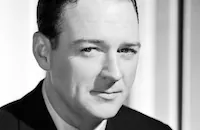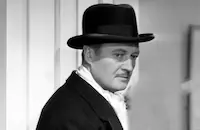Flying Cadets
Cast & Crew
Erle C. Kenton
William Gargan
Edmund Lowe
Peggy Moran
Frank Albertson
Frankie Thomas
Film Details
Technical Specs

Synopsis
At the Monarch Airport, Bob Ames's excitement over receiving backing for his new flight school is dampened when his partner, Trip Hammer, tells him that the money has come from the father of Kitty Randall, Bob's girl friend, to whom Trip is currently giving flying lessons. Trip then gets a phone call from Captain Rodclift "Rocky" Ames, Bob's brother, a World War I aviation hero from whom Bob is estranged. Now a soldier of fortune, Rocky agrees to help with the flying school, in exchange for Trip squaring his gambling debts in New York. Trip convinces Bob that the school needs Rocky's name to attract customers, as well as a government training contract. Soon, the school is attracting students from across the country, but when the flamboyant Rocky arrives, he immediately annoys Bob when he flirts with Kitty. Rocky takes Kitty up for a flying lesson, only to be forced to make a sensational landing when Kitty breaks off a wheel during a simulated forced landing. The flying cadets begin their training, with Bob providing the scientific instruction, Trip the mechanical education, and Rocky the flight training. The top student is Newton Adams, who Trip soon discovers is Rocky's long-lost son. The mechanic agrees to keep Newton's secret until the boy has a chance to prove himself. Unfortunately, while Newton is a whiz in the classroom, he panics during his first flying lesson with his father. Meanwhile, Bob is unable to get flight inspector Taylor's approval on a new plane design until Rocky arrives and renews his acquaintance with Taylor. Bob then confronts Rocky about his attentions to Kitty, but Rocky is told by Kitty that he is "old enough to be her father." The depressed Rocky considers leaving the school to join a flight squadron in China, until Trip accuses him of running away from every responsibility he has ever had. The next morning, a drunken Rocky returns to the flight school. Later, Rocky takes Bob's new plane on a test flight and tells his brother that the plane is not safe. He agrees to take Bob up in the plane himself, but only after the plane is equipped with a spin shoot. Later, Newton, who is the only cadet not passed, overhears his father state that he will never be a flyer. Upset, Newton takes off in Bob's experimental plane, as Trip breaks the news to Rocky that the boy is his son. Rocky then goes after Newton in another plane, and signals to the boy to put on his headphones just before the plane goes into a spin. Newton is told to pull the spin shoot in the nick of time, but Rocky, too involved in watching his son, crashes his plane. Later, at a train station in Glendale, Bob tells Taylor that he has fixed the plane's faulty wing design, and the army has agreed to give him a contract. Newton and the other cadets then board their train, which will take them to report to their respective Army air bases, while the injured Rocky is finally reunited with his wife Mary.

Director
Erle C. Kenton
Cast

William Gargan

Edmund Lowe
Peggy Moran

Frank Albertson

Frankie Thomas
Roy Harris
Charles Williams
John Maxwell
George Melford
Arch Hendricks
Louise Lorimer
Crew
John W. Boyle
Bernard B. Brown
Roy Chanslor
R. A. Gausman
Otto Ludwig
Harold H. Macarthur
Paul Malvern
Jack Otterson
Robert Pritchard
Jaik Rosenstein
Stanley Rubin
H. J. Salter
Seward Webb
Joseph West
Vera West

Film Details
Technical Specs

Quotes
Trivia
Notes
This picture was producer Paul Malvern's first film for Universal. In March 1939, Universal announced that it was making a big-budget film entitled Flying Cadets, to star Freddie Bartholomew and Jackie Cooper, under the direction of Joseph Santley. That film, which also concerned itself with the U.S. government's plans to train civilian youths as aviators, was canceled in May 1939 and replaced on the Universal production schedule with the Bartholomew/Cooper/Santley film Two Bright Boys (see AFI Catalog of Feature Films, 1931-40; F3.4806). It is not known if any elements of the 1939 project were used in the 1941 film.












